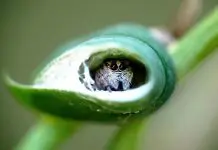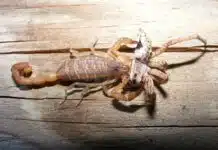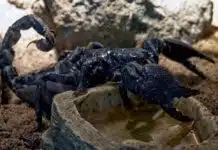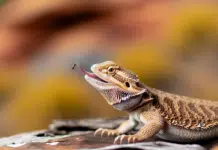Whether you are a new owner or need help building a hedgehog house, you have come to the right place.
In this guide, I will touch on how you can set up a hedgehog home step by step.
You will also understand the pros and cons of different types of hedgehog housing. From pet cages to homemade DIY homes that can be used indoors for your pet or outdoors as a hibernation chamber for wild hedgehogs.
So if you want to find out what cages or homes you should be getting or making, read on!
Contents
Essential #1: Choice of housing
Here we want to compare all types of housing to give you a neutral unbiased view.
There are many types of housing for hedgehogs. Some are meant only for domestic hedgehog, while some can be used for wild hedgehogs too.
Let us see which housing is the best for you:
Commercial pet cages

Pet cages are one of the best homes for your pet hedgehog. They are easy to set up, manage and clean as well.
Advantages of using pet cages
- Easy to clean
- Secure – Don’t have to worry about your hedgehogs escaping
- Wired cages also provide good ventilation
- Pet cage with a solid tray as a base allows the use of the substrate for hedgehogs to burrow under.
Disadvantages of using pet cages
- Can be costly
- Things to take note when getting commercial pet cages
Cage size
Despite hedgehogs small petite size, they can be really active at night. So giving them more space to roam around is always good.
The cage or container size should be between 2 to 4 feet (24 to 48 inches) long and at least 1 to 2 feet (12 to 24 inches) wide.
That said if you can afford something bigger than that please do it. The bigger the better.
Hazards and precautions
- Make sure the cage you choose has a solid tray base instead of a wire base. This prevents the hedgehog’s legs from getting stuck between the wire base.
- Avoid cages with a ramp leading to the 2nd storey. If you do, please secure all the ledges with a fence or something to stop your hedgehog from falling off the ledge and injuring themselves.
- Make sure cage wire bars are closely spaced. Sometimes hedgehog might attempt to squeeze through them and get stuck if the wire cage bars are too wide.
- Also, be sure to cover the top of your cage to prevent hedgehog from climbing out of the cage.
So what type of cages is suitable for my hedgehogs?
You can use a rabbit cage or guinea pig cage as they are pretty much the same. Just take note of the hazards listed above before buying them.
Make sure you only go for cages with a solid base to avoid your hedgehog’s legs from getting trapped. One of them would be this 6 1/4 inch deep tube base pet cage that provides ample space for a running wheel. Or the #1 bestseller guinea pig cage on Amazon will be another great choice. Both cages provide more than enough space for 1 hedgehog.
Another alternative for cages that majority of hedgehog owners are using is undoubtedly the C&C cages aka Cubes and Coroplast Cages. It is considered as a cage and playpen at the same time. Find more information on the playpen in the next section below.
Playpen

The playpen is the next best alternative for a hedgehog enclosure. The playpen is great for its versatility and space.
Advantages of using a playpen
- Flexible and versatile – adjust to the space you want
- Easy to clean
- Easy to store and require less space
Disadvantages of using a playpen
- Some playpen has wider bars in their fence. Can be hazardous to hedgehogs if they attempt to squeeze through it.
- Using common hedgehog substrates like Aspen and Carefresh may dirty your floor. However, you could use other replacement such as a blanket or mat. Note that using a blanket or mat, your hedgehog will not be able to burrow.
Hazards and precautions
- Make sure fence is high enough to prevent hedgehog from escaping
- Also, ensure wire bars of the fences are small to prevent hedgehog to get stuck.
The playpen is versatile and easy to set up. If you have the luxury of space or if space is your priority for your hedgehog home then the playpen is a rather good choice.
If you are going to purchase a playpen, there are some really good options from Amazon. You can go for this non-toxic pet safe powder-coated steel mesh playpen or check out this popular transparent C&C cage where you can customize your own playpen size.
Aquarium

Aquariums are often used for reptiles or aquatic animals. However, they do provide good housing for hedgehogs too.
But they can be quite costly. Minimally, you will need a 20-gallon tank. Which in my opinion is not big enough for your hedgehog.
Before you decide to skip the aquarium completely, let’s take a look at some of its pros and cons:
Advantages of using an aquarium
- Aesthetically beautiful – easy to see through and a better view of your hedgehog
- Doesn’t look like a jail cell compared to a cage.
- Does not have wire bar fence so hedgehogs do not get stuck
- No wire bar fence also means no climbing so no need to worry about them climbing out.
- The enclosure allows the use of the substrate for burrowing
Disadvantages of using an aquarium
- Very expensive if you are going for a larger sized aquarium
- Poorer ventilation. The buildup of ammonia from hedgehog waste can stink up the whole tank
- Heavy and more difficult to clean as the base cannot be detached
- Hedgehog may rub their face against the glass as it is transparent. There are instances where they got injured because of that.
Hazards and precautions
Make sure to pad the inside of your tank with cardboard or something softer. This prevents face rubbing against the glass
Aquarium definitely looks way better than many other types of housing but they come at a higher cost and maintenance. So if aesthetics is what you prefer, the aquarium definitely is something for you.
So if you plan to use the aquarium tank as your hedgehog home, you can consider going for a 20-gallon aquarium tank that provides enough space for your hedgehog to move around. Also, make sure to get a proper screen lid cover instead of a solid cover to provide more ventilation. Alternatively, don’t use any cover at all.
Cardboard cage DIY house

Cardboard home for hedgehog is practically free. Just use any leftover cardboards from parcels or wine bottles and tape to create a nice space for your hedgehog.
Advantages of using a DIY cardboard home
- Environment-friendly since you are reusing cardboards
- Lightweight
- Free of charge – super cost-efficient method
- Can be used outdoors for wild hedgehogs to hibernate in
- Allow the use of the substrate for burrowing
Disadvantages of using a DIY cardboard home
- Hedgehog waste can get soaked into the cardboard making it smell terrible.
- Poorer air ventilation will cause ammonia to build up
- Might be difficult to clean. The only way is to change the whole thing.
- Cardboard attracts pest like cockroaches, spiders, silverfish and many more.
- Require time and effort to build it
- Difficult to place a water bottle for drinking. You have to use a feeding dish instead
Hazards and precautions
Make sure cardboard walls at the sides are at least 14” or higher to prevent hedgehog from climbing out. They can injure themselves.
If you have the time to DIY your own home, cardboard housing is a really suitable cheap alternative for your hedgehog. They can be crafted easily to your preferred size and shape. You can also use cardboard housing to help wild hedgehog with its hibernation.
How to make a hedgehog home using cardboard step by step
Items required:
- Scissors or box cutter
- Tape
- Gloves
- Cardboard can be from a shoe box, wine bottle box, or just cardboard.
Step 1: Cut an entrance – approximately 14 to 15 inches should be fine.
Step 2: Use leftover cardboard to create a tunnel.
Step 3: Using the size of the tunnel cut out holes to fit the tunnel.
Step 4: Tape them together.
Step 5: Add in hedgehog substrate or bedding.
DIY Plastic container

Large plastic containers are another great way to DIY your hedgehogs home. They can be used for domestic hedgehogs or for hedgehogs in the wild too.
Advantages of using a plastic container home
- Environment-friendly since you are reusing the plastic container
- Lightweight
- Easy to clean
- Free of charge. Cost efficient
- Allow the use of the substrate for burrowing
Disadvantages of using a plastic container home
- Drilling is required for air ventilation
- Difficult to place a water bottle for drinking. You have to use a feeding dish instead or attached a holder to the plastic container.
Hazards and precautions
Make sure plastic container is at least 14” or higher if you are not using a lid. This is to prevent the hedgehog from climbing out and injuring themselves.
How to make hedgehog home with plastic container step by step
Items required:
- Drill
- Soldering iron
- Gloves
- Large plastic container
Step 1: Drill holes into plastic container cover or sides for ventilation.
Step 2: Position the water bottle on the side of the plastic container at the height you want and create a marking for the water tube to go through.
Step 3: Water bottle should come with a bracket. So you need to do another marking for the screw to hold the bracket.
Step 4: Using soldering iron, melt a hole at for the water tube valve and drill a small hole for the screw that holds the bracket.
Step 5: Attach the bracket with the screw.
Step 6: Finally, attach the bottle on the bracket and drinking tube through the hole you just made.
Which housing is the best for hedgehogs?
There is really no best option. All 4 containers type has their pros and cons. It really depends on your preference and what materials are available to you.
What are your priorities? Is it the aesthetics or the ease of cleaning? Or maybe cost is your priority? So ask yourselves some of these questions to better make the decision on housing.
You don’t have to make a decision now too. Read on to see what are the other essentials for a hedgehog home become you conclude what housing best suit your hedgehog.
Let’s go on to essential #2 for a step by step guide in setting up the housing for your hedgehogs.
Essential #2: Hedgehog cage positioning
Now that you are done with cages, you might be wondering… Where to put the hedgehog house?
Hedgehog should stay in temperatures between 74°F – 78°F (approximately 23°C to 25°C). So it is important not to set their cage or housing anywhere near air conditioning or heaters where temperatures can change drastically to hot or cold.
It is best to position them in the corner of the room or basement away from the window but yet still able to experience day and night. Hedgehogs are nocturnal, it is good for them to know when is night and daytime to wake up and sleep accordingly.
For hedgehog in the wild, you might want to place their homes somewhere in the outdoors under a shade.
Essential #3: Hedgehog bedding and substrate
Bedding and substrate are what you use at the bottom of the cage. This is where your hedgehog’s feet and body come in contact with almost every day. So if they are sensitive to the bedding, there is going to be a real problem later.
Here, we look at some of the recommended hedgehog bedding that is safe for hedgehogs
Fabric type bedding
Fabric liners like fleece, towels, and pillows are all popular examples of fabric type bedding or substrate.
Most people use them because they are easy to clean and are loved by most hedgehogs.
Advantages of using fabric types as bedding
- Get choice for owners who are allergic to wood shavings and hedgehog that are more sensitive to dust.
- The fabric liner is mostly soft and comfortable. So there won’t be any problems with abrasions or related injuries.
- Pillow also help to absorb the fall if your hedgehog happens to fall from a higher level. (This is for those with the 2nd level in their cage)
- Easily reusable by washing.
- Lower cost since it is reusable.
- Not messy like wood or paper shavings
- Lower the chances to harbor mites
- Light color fabrics also allow you to see the color of hedgehog poop clearly
Disadvantages of using fabric types as bedding
- Some fabric material may have loose threads or small fiber sticking out. Hedgehog toes are tiny, they may get entangled with loose threads resulting in injuries.
- Regardless of which type of fabric material you use, they must be changed once every few days to a week.
- This is especially if your hedgehog is not “litter box trained” (potty trained). Fabric will soak in their pee and feces causing bad smell and bacteria build up.
- Hedgehog love to burrow. They won’t be able to burrow under some fabric. Or even if they do, they will make a mess, shifting the fabric around leaving the bottom of the cage exposed.
- Fabric can cause accessories within the cage to shift, topple or move. This includes your water and food dish.
What are some examples of fabric bedding?
Vellux blanket

They can be easily bought in stores or online. Comes in a large piece so you can cut them up into smaller sizes that fit your cage.
These blankets are quite sturdy and do not change shape even after numerous washing. They can also withstand scratching from hedgehogs.
Do not use bleach on the vellux blanket as it can destroy the fabric.
You can check out some recommended options for vellux blanket types on Amazon here. Just try getting one of the cheaper ones first and feel it for yourself how comfortable it can be before getting more.
Fleece pouch, blanket or bed

Fleece is a low-cost material that can last really long. Similarly to vellux, fleece should not be bleached or they will break down.
If you prefer fleece, here are some affordable fleece blankets for pets. You can also check out this amazing fabric liner from Amazon that comes with a pocket sleeve for burrowing.
Or alternatively, take a look at this stylish fleece bed for hedgehog from Etsy below. Doesn’t it look all comfortable and cozy?
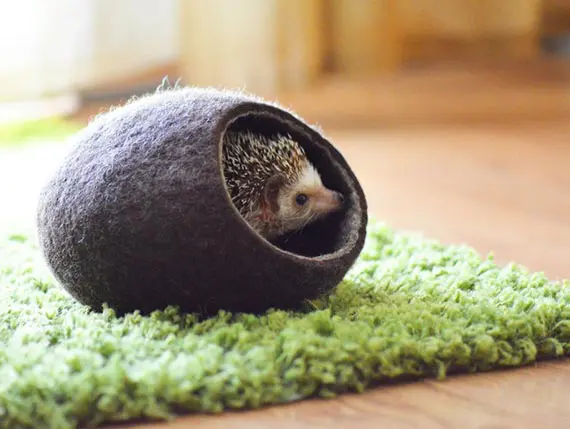
However, if you are on a tighter budget, you can still pamper your hedgehog with a warm and cozy fleece bed that is a more affordable option featured in Amazon.
Crib bumpers/liners or thin pillow
This crib liners or bumpers are used for babies. They are easily available and are also not too expensive. They provide hedgehog protection as they are soft and can also absorb impact.
Precautions and solutions for using fabric types
- The fabric might appear to be neater compared to shavings, but they have to be washed frequently.
- So if you are planning to use fabric, prepare at least 6 to 7 spare liners or towels to ensure there is enough as a replacement while the dirty ones are still in the wash
- Base fabric can shift if hedgehog attempts to burrow under it. To solve this you can consider the following:
- Tie down the base fabric to prevent it from shifting much
- Anchor down accessories with velcro
- Add in other extra items to burrow or snuggle so that they are less likely to burrow under the base fabric.
- Avoid fabric that produces loose threads or small fibers that will entangle of their foot.
- Best to use light colored fabric so that you can see changes to your hedgehog urine and stool colors
- You may also want to use detergent for sensitive skin to reduce the chances of skin irritation
- You can also use an absorbent layer under your fleece liners to reduce bad odor.
Crib bumpers are another cheap and effective form of protection for hedgehogs. Take a look at some crib bumper pad options here.
Wood type bedding
Wood type substrate is great for the hedgehog to burrow under. Using wood shavings allows them to feel all cozy and warm under.
But the main reason for using wood type bedding is to remove odor. As wood bedding are all great absorbents, they are able to draw moisture out of feces and urine thus eliminating odor.
With all that said, they have also been up for debate in recent years on whether they are safe for hedgehogs or are toxic to them.
Let’s take a look at some pros and cons of wood type bedding:
Advantages of using wood shavings
- Easily accessible
- Allows burrowing
- Absorb urine hence lesser smell.
Disadvantages of using wood shavings
- Shavings have to be replaced weekly. It might be cheap to buy it once but as it needs to be replaced often, it is not as cheap compared to other bedding options
- Wood shavings can cause a mess
- Shavings like cedar can be toxic to hedgehog
- Shaving dust cause respiratory problems
- Chances of mites infestation
Wood shavings may have certain disadvantages but not all wood shavings are bad for hedgehogs. Let’s explore all the various wood type beddings to see which are ones to best avoid and those that are suitable for use.
Pine or cedar shavings

Pine and cedar shavings are one of the most common material as a substrate for many animals. Hence they can be found easily at any pet shop or online. They are also not expensive either so they make a really great option for many owners.
But here’s the deal
- Shavings are dusty – They can cause respiratory problems
- Cedar shavings contain plicatic acid
- Pine shavings contain abietic acid when not cured
If you were to ask me, I will strongly advise you to avoid using any of these wood shavings. Especially cedar shavings, they are an absolute NO.
You can still use pine shavings as the last resort when there is nothing else to use. But that is unlikely as there are so many other options.
Aspen Shavings
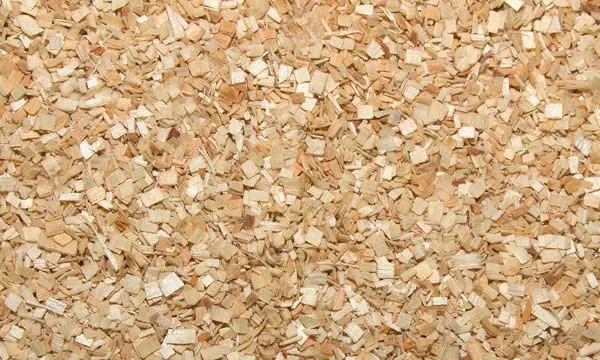
Aspen is the only wood shavings that are safe for hedgehogs. They are also finer than pine or cedar shavings.
Advantages of aspen
- Inexpensive
- Easily available in pet shops and online
- Able to absorb urine like other wood shavings
Disadvantages of aspen
- Dusty – dust is also sticky. Can stick onto blankets etc
- Can be messy
- Rougher texture – a small chance of injuring hedgehog eyes
- A weaker absorbent of waste hence will be more stinky compared to other wood shavings
- Chances of mites infestation
Based on the pros and cons of aspen, they are a good replacement of cedar shavings. However, I still personally won’t recommend them as their texture are often coarse. If it gets into your hedgehog’s eyes, it is going to post a real problem.
Pelleted Wood Bedding

Common wood pellet beddings are pine horse bedding or pelleted pine kitty litter. These 2 are most suitable for hedgehogs.
There is also pelleted aspen that is another widely used choice. These wood bedding are not exactly shavings but more like pallets. So they are less dusty and cause no respiratory problems for hedgehogs
Advantages of pelleted wood bedding:
- Absorb moisture hence little to no smell from hedgehog waste
- Easier to clean compared to shavings. Using pellets allow you to spot clean.
- They are not sticky like pine and cedar shavings so they are unlikely going to stick on your hedgehog skin
Disadvantages of pelleted wood bedding:
- Hedgehog may eat the pellets resulting in serious impaction.
- Pellets will break down into dust after a while. So it might get messy after a while.
- If hedgehog feet is too tiny, it can be hard for them to walk on.
- Chances of mites infestation.
My Thoughts?
Personally, I am not a fan of wood substrate. They get messy and tend to be more hazard-prone to hedgehogs. I don’t know about you but I am sure not going to take any chances on them just because of the smell.
What do you think? Do you prefer wood?
If you do, the only few wood substrates that are commonly used by hedgehog owners are the Kaytee soft granule blend bedding made from wood fibers or the Care Fresh complete natural bedding that you can get both from Amazon.
But before you make a decision let’s look at the next bedding type…
Paper type bedding
Paper type bedding is one of the top options for many owners as they are somewhat similar to wood bedding but without the dust and mites.
There are several brands and paper bedding types. Let’s check them out individually:
Fluffy paper types aka CareFresh

There are several brands for fluffy paper type substrates. Carefresh is one of the recommended brands among many hedgehog veterans.
Advantages of Carefresh
- They are made out of wood pulp hence they are light and fluffy. Think cotton but slightly harder.
- Very absorbent hence reduces odor.
- Do not break down when it is wet.
- Produces little dust compared to wood shavings. But note that the more hedgehog burrows or roll in around in the substrate the more paper dust it will produce.
- Comes in many colors – Recommended to go for lighter colors to be able to check for any abnormality in urine and stools.
Disadvantages of Carefresh
- Hedgehog may eat the bedding. And when it gets wet in the stomach, the paper will expand potentially causing impaction within.
- There is a chance for pieces of Carefresh to fall out of cage or housing so some cleaning up is required.
Not odor free. Cleaning is still required every 2 to 3 days.
There are 2 paper bedding that is commonly used for hedgehog cages. They are the Care Fresh natural paper bedding or Kaytee clean and cosy paper shavings. Both shavings are made of natural ingredients and provide a soft texture that is 100% safe for your pet. Most importantly both of them are great odor absorbent bedding.
Pelleted Newspaper bedding
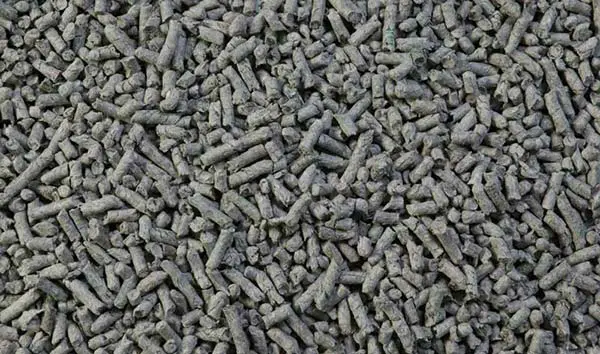
Some example brands of pelleted newspaper include Purina yesterday’s news and second nature dog litter. Such pellet bedding is usually used in the litter area as they are great absorbent of smell and moisture. These pelleted products are made from recycled newspaper. So they are not toxic.
Advantages of pelleted newspaper
- Environmentally friendly as most of them are recycled paper
- Reduce smell as they absorb moisture
- Easily available
Disadvantages of pelleted newspaper
- Hedgehog may ingest them and when mixed with water they expand causing impaction
- Most of them are dark in color. You will not be able to differentiate between pellets and poop.
Final thoughts on bedding?
Out of all 3 types of bedding, I strongly recommend going for fabric type bedding or at least the paper ones. Avoid wood ones totally. They are definitely not worth it. Paper ones can be equally as good absorbents.
I recommend that you can choose between Carefresh paper bedding or fleece fabric liner or blankets. Carefresh lowers the intensity of the odor while the fleece and vellux blanket are really easy to clean and replace. So ultimately it is up to your preferences and priorities.
So what bedding will you prefer? While you are deciding on one, let’s move onto the next section on accessories.
Essential #4: Food and water accessories
Food and water are the main essentials for any pet. Hedgehogs are no exception. So this section, let us explore how to set up food and water stations for your pet hedgehogs.
Food station accessories
Food station should be placed away from the litter box. You will also require 2 bowls: 1 for soft food and the other for hard food.
Here are some pro tips for food bowls:
- Use a heavier bowl – to weight down so that they are not easily toppled.
- You should use a dish or bowl that is at least 4 inches.
- It should also be slightly tall so that bedding does not go into the food bowl.
- You can also set the bowl slightly higher on top of another accessory. This also provides additional exercise for hedgehogs to reach out to their food.
- You can glue your bowl or dish down onto a flat surface like a tile to prevent it from toppling.
Food bowls that are suitable to use:
Crock bowls for pets
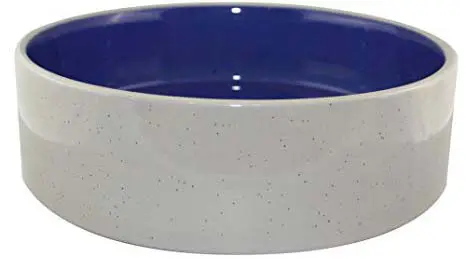
Crocks are earthenware pots used for cooking. There are also smaller ones that are meant for pets. They look like saucers that restaurants will use to hold sauces for food.
Choose ones that are heavy and a wider base so that they do not topple so easily.
So what sizes of crocks are most suitable?
You can use 2 ½ inches to 3 inches size crocks for juveniles and baby hedgies. 4 inches ones for adult hedgehogs will be just nice.
Lastly here are some precautions when using crocks:
- Make sure to check crocks for cracks or chipped edges. You don’t want your hedgehogs to get cut.
- Glue crocks to the base of anything that is heavy to prevent toppling or shifting of the food bowl.
- Always sterilize bowls before using
You can get 3-inch crock bowl here from Amazon. Or if you need something slightly larger, here is a 4-inch crock bowl for sale.
Reptile dishes
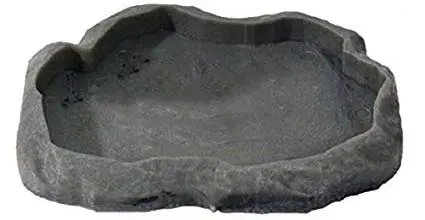
Reptile dishes are great alternatives to crock bowls. The reason is that reptile bowls have a wide and low base. Makes it easy for hedgehogs to eat or drink from, while it’s low center prevents it from toppling.
The downside for using reptile dish:
- With its low base, bedding might get mixed into the bowl, increasing the chance of your hedgehog unintentionally eat them up.
- Since it is easy to climb in, a hedgehog might mistake the food bowl as a litter box.
- Might be more difficult to clean
- Can also be costly
Similarly, if you are going for reptile dishes, use those with a low base to prevent toppling over. Here is a cheap reptile dish with a good wide and low stable base.
Coop cups for birds

Coop cups are usually used for birds and rabbits. They can be attached to the side of any wire cage as they come with brackets. They are quite similar to the water bottle that is used in pet cages.
Usually, the set up for coop cups in hedgehog cage is to place bowls higher to prevent bedding from getting mixed into the food bowl. This also encourages hedgehogs to exercise while eating since they have to reach up to get food.
This action, however, encourages climbing which is not something we want. Once they are exposed to climbing behavior, they will start to climb often.
We do not want that to happen as it will cause injuries from falling. Their feet are also not made for climbing.
But if you are able to place them at the right height for your hedgehog to drink from without climbing too high then using the coop cup will be fine. Here is a good and affordable coop cup you can get from Amazon.
Water station accessories
Water keeps hedgehog hydrated. It is a vital part of their diet. You can choose to use a water dish or water bottle to hold water for drinking.
Let’s look at their pros and cons individually before you make a decision:
Water bottle dispenser

The water bottle is usually hung outside of the cage or plastic container where there is a tube that acts like a straw to channel water into the cage. Just like a tap, hedgehogs can drink directly from the bottle’s tube.
Advantages of using a water bottle
- Less maintenance and cleaning
- Less messy
- More floor space
- Syringe or tube fed hedgehog seems to prefer bottle more
Disadvantages of using a water bottle
- There are hedgehogs that hurt their teeth or mouth drinking from bottles.
- Some hedgehogs might find it intimidating so they won’t drink from it.
- Water bottle must be checked frequently to make sure it is working. As there are instances where food or bedding got stuck in the tubing of water bottles.
For bottles, you should only look at no drip, leak-proof ones from Amazon and nothing less.
Water dish

Water dish or bowls are the simplest way to provide water to your hedgehogs. All you need is a bowl of a suitable height and hedgehogs will start drinking from there.
Advantages of using a water dish
- Easy to clean
- Less of a hazard to their teeth and mouth
- Cheap
Disadvantages of using a water dish
- Water from the dish can spill or topple causing the area around it to become wet. Hedgehog may get drenched and feel cold in the night.
- Does not hold a lot of water
- Refills or water change have to be done often depends on the size of the bowl
- Harder to monitor if hedgehog drank or not
If you prefer to use a feeding bowl for water, it will be a good idea to get a bowl with a flat and stable base on Amazon here as a lower base will lower the chances of toppling and spilling over.
So which do you think is better? Water bottle or water dish?
Well… that really depends on your hedgehogs. Some hedgehogs do not like bottles at all, they don’t even go near them while others seem totally fine with them.
Both methods have their pros and cons so at the end of the day there really isn’t anyone method better than the other. The important thing is to make sure you monitor whether your hedgehogs are actually drinking enough from their dish or bottle.
Do check out the water section of our hedgehog food guide if you still can’t make up your mind between water bottle or dish.
Quick note, if you prefer bottles, you can also check with the breeder if the hedgehogs are water bottle trained before buying one.
So that is all for food and water stations. Let’s move onto the next topic of setting up their litter area.
Essential #5: Setting up a litter pan or box
The litter pan or area is a designated area for the hedgehog to do their “big” and “small” businesses.
You will have to train them to do it. There ways to encourage them to use the litter areas but most of the time they require training and conditioning.
There is some hedgehog that requires little coaxing before they start using the litter pan while some take years and still do not attempt to use it.
Nonetheless, we should still set up some space in a cage or containers for littering.
Here are some pro tips for setting up your litter pan:
- Easy access – Litter pan or box opening should be low enough for the hedgehog to climb in fully.
- Spacious – It should also have space for them to move around in it.
- To encourage hedgehogs to use litter pan and box, start off by collecting some of their feces and place them in the litter area.
- You should also use a different substrate in your litter area than the rest of the cage.
- You can choose paper substrates from the above options
Essential #6: Hideouts
Hideouts are important for a hedgehog. They like to curl up in warm and cozy places so you will need a hideout for them to burrow into.
What makes a good hideout?
- It should be dark
- It should have enough space for the hedgehog to move and turn about or go in and out.
- Best to have a tunnel entrance and exit where they can burrow into
Examples of good hideouts:
Fleece bag or snuggle sack

A fleece bag or sack can act as a sleeping bag for the hedgehog to snuggle and sleep in. They are warm and really nice to touch. Bags should have an opening large enough for the hedgehog to get in and out.
Precautions on fleece bags
Hedgehog does urine and poop in the bags too so always get more spares in case the other bags are in the wash.
You might as want to check for loose threads or fibers as they can entangle your hedgehog feet causing injuries.
Alternatively, you can also use a fleece cloth or blanket. Some hedgehogs prefer to go under the cloth like a blanket instead.
But if you are looking for fleece bags, here is a fleece bag that can really keep your hedgehog warm and cozy.
PVC pipes

A cheap and effective substitute for sleep bags. PVC pipes can be a great burrowing accessory for your hedgehog.
PVC pipes can also be used as tunnels to connect them from one container to the next. A good way is to compartmentalize their housing into a few areas using PVC pipes to connect from one room to the other.
You want to get a PVC pipe that is at least 4 inches wide in diameter. This provides sufficient space for them to burrow into the pipe without getting stuck.
Igloos
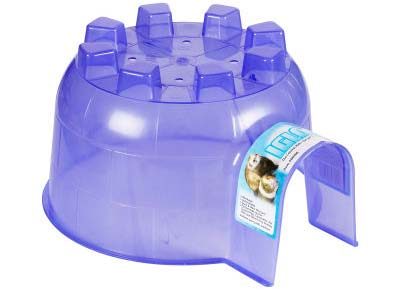
The 3rd option in line is a toy igloo. Made of plastic, the igloo can be a good substitute hideout that is easy to clean and wash. It goes really well if you are using paper type substrate.
In some cases, the hedgehog may drag a fleece bag into the igloo to lie or snuggle in. This gives them extra warmth and security.
Igloos you choose should also come with a mini tunnel as hedgehog loves burrowing into those tunnels.
Here is a cute plastic igloo house for hedgehogs that are commonly used by many pet owners.
Plush cushion cotton cave bed
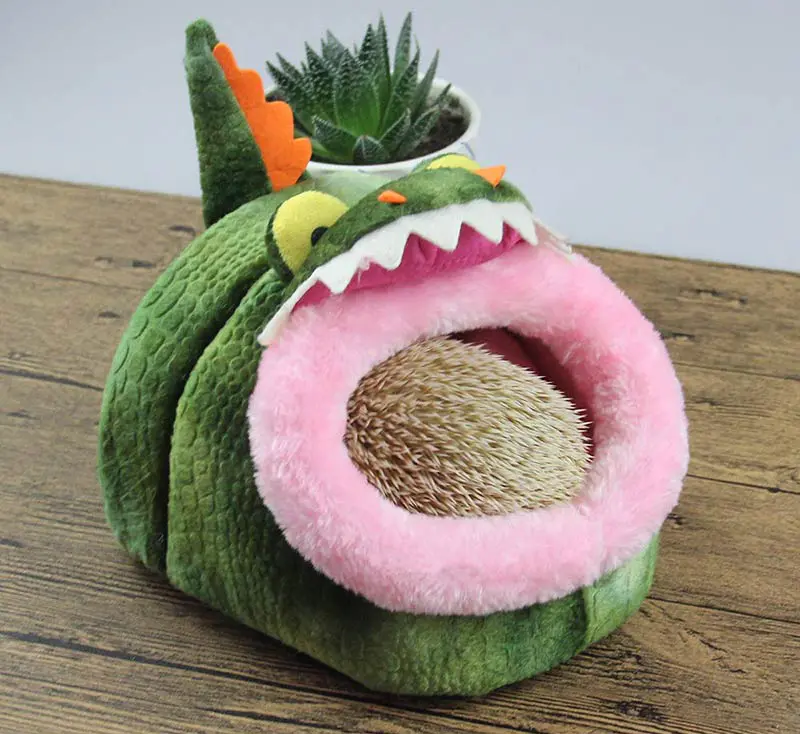
As hedgehogs love to burrow into cozy places, getting a plush cozy cotton cave bed is also a great alternative hideout. They provide a warm, comfy “sleep and hide” compartment that hedgehog loves.
However, sometimes hedgehogs can pee and poo in their caves. However, the great thing about these plush cave beds is that they are removable with a zipper and is easy to wash.
Here are some plush cave bed options that are popular.
Plush Tunnel Cave
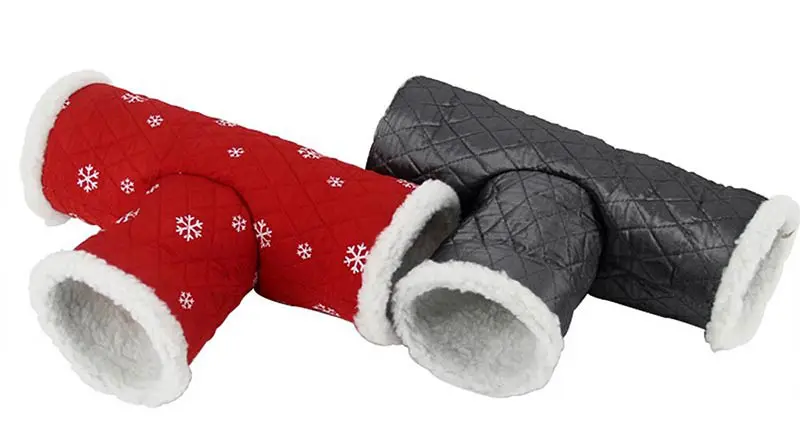
Speaking of burrowing, what could give hedgehogs the best pleasure of burrowing other than tunnels! Yes, this is an upgrade from PVC piping. T-shape tunnel with cotton plush as inner material allows hedgehogs or any other small pets to dig deep and sleep within.
Although this type of tunnels can be easily washed but it might not be easy to clean them thoroughly as you can’t flip them from inside out.
If you like to pamper your pet hedgehogs, you can find these plush tunnel caves with different shapes and sizes here.
DIY cardboard
Cardboard is the cheapest alternative that you can find around. They are lightweight and are easy to dispose off once they are dirty. Then just create a new one.
Cardboard like wine or shoe boxes can be customized to whatever shape or size you like. They work very well with substrates and fleece. Just throw a fleece underneath and you will see your hedgehog burrowing into the cupboard for their nap.
But just so you know, the hedgehog may urinate or poop in the cardboard. So you maybe have to lift it up to see once a while and change them when necessary.
So many options what to choose?
Now, these are the 4 commons hideouts most owners use. There are plenty more. You can always head over to Amazon or Etsy to find more varieties of hedgehog hideouts.
For me, I prefer to use a fleece sack as you can take them out of their cage while they are asleep and have some bonding time with them while they are in the bag.
So every hideout their own pros and cons. You might want to try them all out too as they are not expensive.
Essential #7: Toys and exercise accessories
Hedgehogs really love to have fun. Throw in some toys for them to play is a great way to keep them fit. So let’s take a look at some toys and exercise options
Exercise wheel
Hedgehog love running on wheels. You will find them running on wheels in the middle of the night. The active ones can run miles on the wheel in one night.
Wheels you want to get should be the largest wheel size. You want them to measure between 11 to 12 inches in diameter and between 5 to 6 inches in running width.
You will also need at least 16 inches of height space in your cage or container to fit the wheel in.
Here are some examples of running wheels:
Bucket wheel

These wheels are durable and easy to set up. You can even DIY on your own. They do not use spinning bars or axies hence lower noise.
Advantages of using a bucket wheel
- Very durable
- Easy to set up and clean
- Make less noise compared to other wheels
Disadvantages of using a bucket wheel
- Not easy to get
- Priced between 20 to 30 dollars
Bucket-wheel is my personal favorite. I am using one of those myself. The noise produced from the bucket wheel is really softer compared to previous wheels I was using.
Here is an example bucket wheel that is suitable for small pets.
Comfort wheels
These wheels are similar to bucket wheels except their pin is made of plastic and they may break easily after several uses.
But what is so great about the comfort wheel is that their treads provide traction for hedgehogs to run on so they tend to prefer comfort wheel more than bucket wheels.
You can check out the best seller for comfort wheel here at Amazon.
Wodent wheels
These wheels provide hedgehog privacy while they exercise. And you know how hedgehogs love their privacy. Put these wheels side by side and your hedgehog will choose the wodent wheel over other wheels any day.
The downside?
They may start treating the wheel as their permanent litter box. Also, they can be pretty difficult to clean as you have to dismantle the wheel in order to clean its interior.
Here are some suitable options for wodent wheels.
Wire mesh wheels

These are metal wheels that are made of metal mesh. They are definitely more durable but the gaps between wire mesh can potentially hurt your hedgehog if their tiny feet gets trapped.
So word of advice, use a solid bottom wheel like the ones above instead of wire mesh ones. Even when gaps are small, your hedgehog nails can still get stuck.
If you are planning to still go for wire mesh types, do go for wire mesh wheels with smaller gaps like this.
Toilet paper tubes

This is one of the most widely use toys and are hedgehogs all time favorite. They love squeezing their heads into toilet paper tubes but sometimes they squeeze their heads in so hard that they get stuck.
To solve this problem, cut the tubes so that they are shorter. A good gauge is to cut it in half. This way even if they get stuck they can still breathe. And coming out from a half tube is must easier.
Critter exercise balls

These critter exercise balls are a great way to protect a hedgehog while they are exploring their surroundings while giving them good exercise.
You can get a critter exercise ball of about between 12 to 13 inches. That is more than enough space for them to safely run within it.
But here’s the deal
Some hedgehog might not use them. On top of that hedgehog may poop while they run. It can cause them to drench themselves in their own poop.
The ball also does not provide good ventilation and the slits or tiny opening on the ball can rip off hedgehogs nails if they get stuck in between.
So whether or not it is good, still it depends on your hedgehog. I have seen hedgehogs having a good time in those balls, I have also seen ones that ignore them totally.
For exercise balls, get those with larger holes for ventilation. Exercise balls with larger ventilation will also help them to detect food scent. This way you can place food outside of the exercise balls to entice and trick them to start moving from within the exercise balls.
Dig boxes for foraging
Dig boxes are a great way to encourage exercising and promote a fun time foraging for insects or food.
Check out this complete dig box setup for sale on Etsy:

Or DIY one on your own like the image below:

All you need is a simple plastic container from Amazon and fill it up with some cheap fleece strips from Etsy.
Here’s how you create your own dig box step by step:
- Use a plastic container or cardboard, cut out an access point for them to enter and exit. You can also add a tunnel to the entrance using a shoe box, cardboard or PVC tube. Anything that can hold it’s shape.
- Fill the box up with fleece strips or suitable bedding substrate.
- Then throw in some insects or food for your hedgehogs to find them.
- Remember to remove any uneaten food and insects or they will rot. Clean your dig box often to prevent bacteria growth.
Other toys that they can burrow or snuggle with
Some examples include stuffed animals, fleece cubes, fleece strips, tunnels, cardboard, dry leaves or grass are all good materials to use for burrowing or snuggling.
Most of these items listed here are really cheap. you can even get some of them from your own home or garden.
Always make sure to wash any stuffed animal, fleece cubes and strips every week to keep them clean.
Conclusion
With a complete understanding to set up a hedgehog home, what do you think?
Not so easy after all right?
Setting up their home can be tedious but definitely fun and enriching. Especially if you are planning on building a DIY home for your heggies.
So feel free to let us know if I missed out anything essential or share with us some of your favorite accessories and toys that your hedgehogs can’t leave without in the comments section below.
Have fun building your hedgehog home!

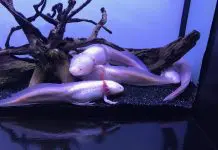

![Sick Axolotl, Fungus, Stress Symptoms [Axolotl Illness Guide 2025] Axolotl fungus](https://exopetguides.com/wp-content/uploads/2018/06/axolotl-218x150.jpg.webp)

